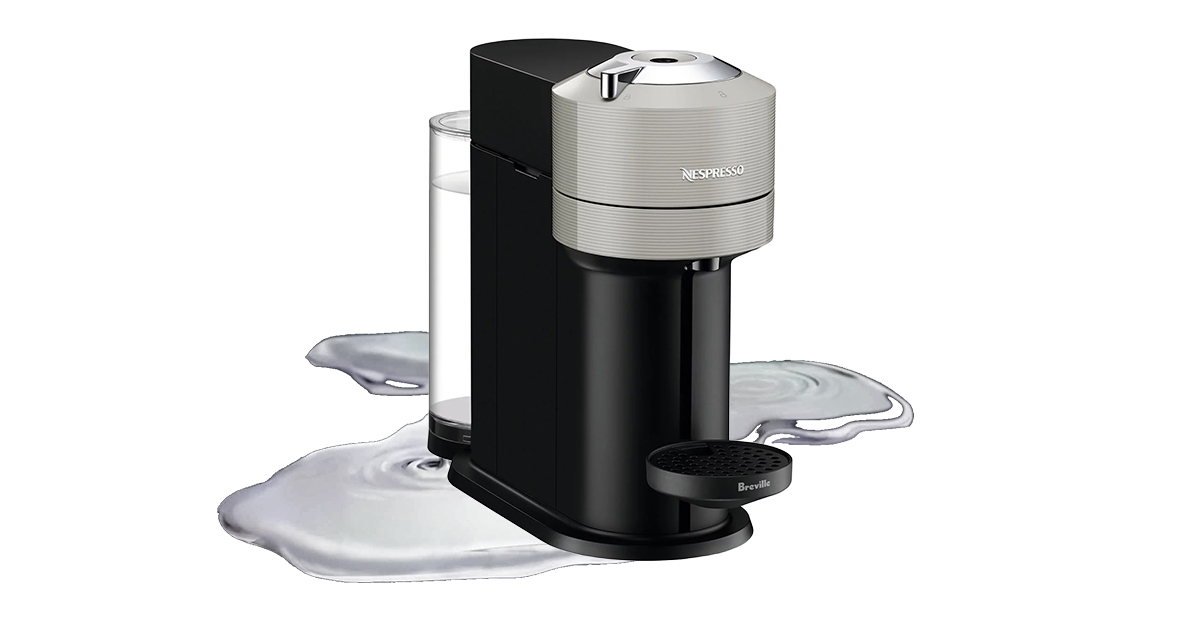Have you noticed a puddle of brown water underneath your Nespresso machine?
Nespresso leaks can cause damage to your coffee maker, countertop, or other surfaces. It can also lead to water supply problems if they aren’t promptly fixed. Even brand-new Nespresso machines can sometimes face this leaking issue.
Fortunately, there are several reasons why this might happen, so it’s important to understand the potential causes to resolve the problem effectively.
In this article, you’ll learn about common reasons why your Nespresso machine leaking and what you can do to fix it.
Before getting into detailed solutions, rule out these basic fixes first.
- Ensure the water tank is properly positioned.
- Check the tank for damage.
- Avoid overflow in the cup support or drip tray.
- Inspect the drip tray and cup support for damage.
Why Is Nespresso Machine Leaking?
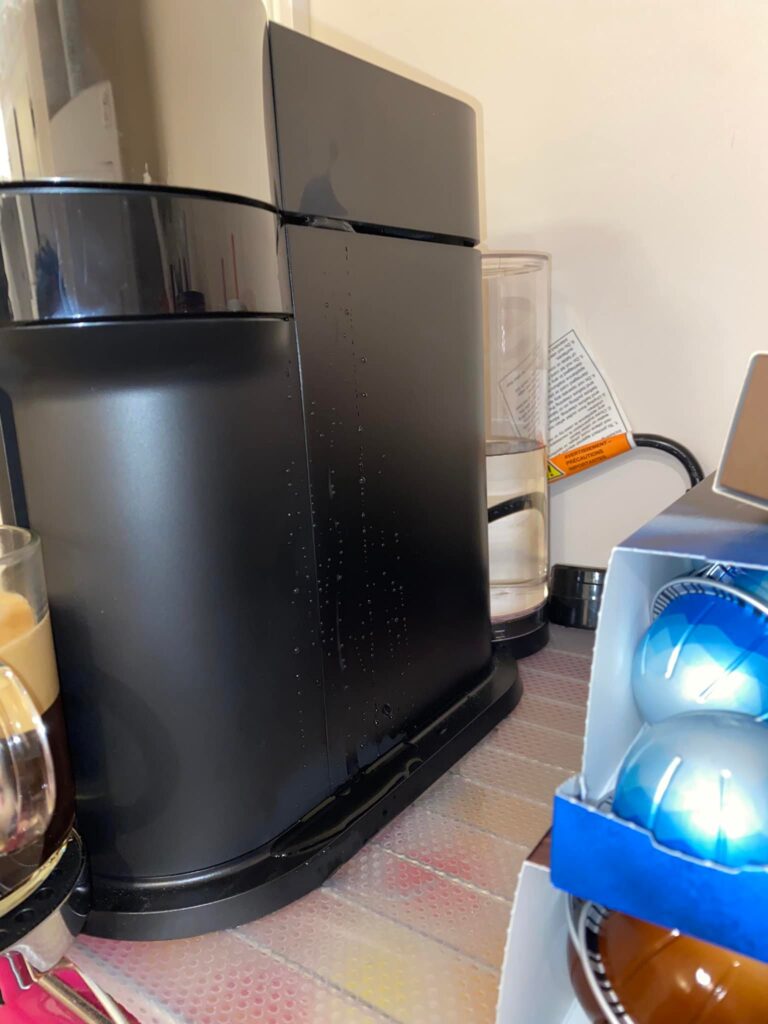
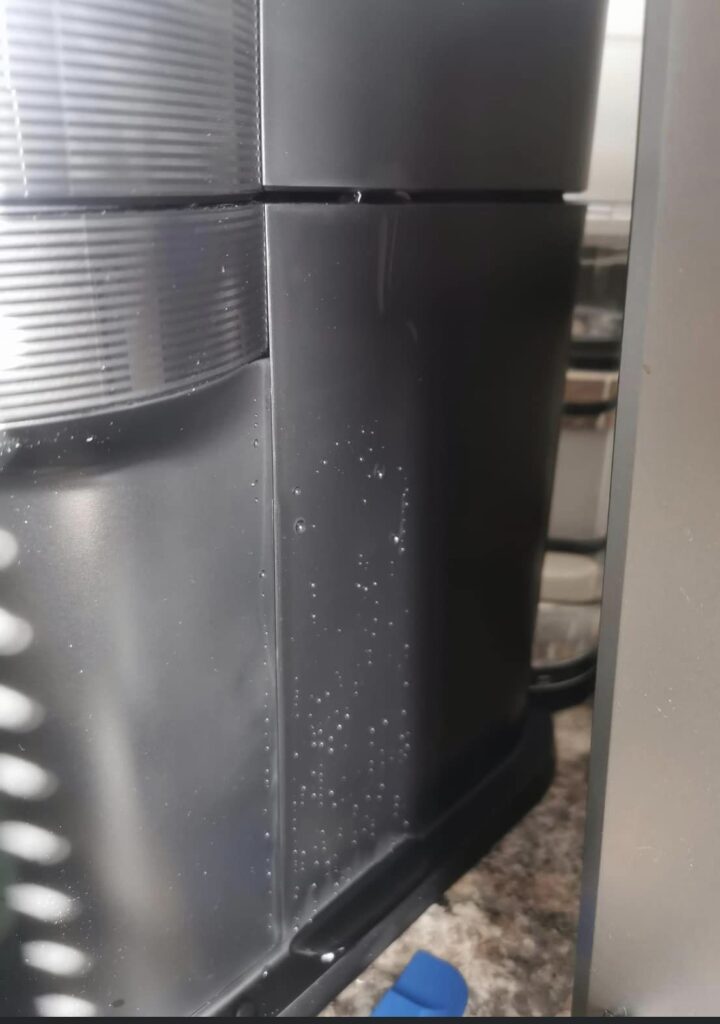
If you’ve spotted a leak under your Nespresso machine, it’s crucial to find out why it’s happening to prevent further issues. The lifespan of a Nespresso machine, which typically lasts between five and ten years, greatly depends on how well it’s maintained. Leaking is a known issue that some Nespresso models like Vertuo Next, Pixie, Inissia, Vertuo, Pop, and Essenza tend to leak.
To ensure your machine serves you well for years to come, it’s essential to identify and fix leaks promptly. Here, we break down four common reasons your Nespresso leaking:
- Nespresso needs descaling – Over time, internal blockages can occur, requiring you to descale the machine to remove these obstructions.
- Blockage in the coffee outlet or capsule holder – Sometimes, the coffee outlet or the capsule holder gets blocked, causing Nespresso leaks.
- Water tank valve seal is worn out – The seal on the water tank valve can wear out over time, necessitating a replacement to prevent Nespresso leaks.
- Issues with internal components – Apart from the above reasons, there might be other issues with the internal components that are causing the Nespresso leak.
Let’s delve into each of these issues to find effective solutions to your Nespresso leaking problem.
How To Fix Nespresso Leaking From Bottom
Let’s pinpoint the potential issues that can cause your Nespresso machine to leak from the bottom.
Nespresso Needs Descaling
The very first possible reason for leaking Nespresso is internal blockages that are preventing it from functioning properly. Over time, coffee residue and hard water can build up in the machine and cause various problems, including red or orange light errors and water or coffee leaking underneath.
To keep your machine running smoothly, it’s recommended to descale it every three months or after every 300 coffees, whichever comes first. Descaling involves running a special solution through the machine to remove mineral buildup from its internal parts, helping to clear any obstructions that might be causing problems.
You can try descaling your Nespresso machine as a first step to see if that fixes the problem. If you’re unsure how to do this, follow the step-by-step instructions.
Nespresso Descaling Steps
I’ve written comprehensive guides on how to descale Nespresso VertuoLine and OriginalLine machines.
The most efficient way to do this is to use a descaling solution. Homemade solutions using vinegar do not work as well as commercial ones. I recommend Nespresso Descaler offers the best bang for your buck and the best for the environment!
- Empty the capsule container and drip tray.
- Mix 0.5 liters of fresh water with a unit of descaling solution in a container.
- Close and lock the machine, then press the coffee button to start it. Wait for the light to stop blinking.
- Eject any remaining capsules from the machine.
- Press and hold the coffee button for 7 seconds until the light blinks rapidly. Do this within 45 seconds to enter descaling mode.
- Turn the lever to lock and then unlock it. Hold the button for another 7 seconds.
- Place a container under the coffee outlet to catch the wastewater, lock the lever, and press the button to start the descaling process.
- After the process, rinse the container and drip tray. Refill the water tank with fresh water and place it back under the spout.
- Press the coffee button again. Once the light stops blinking, the machine is ready to use.
- Allow the machine to cool down for 10 minutes before using it again.
Water Tank Valve Seal Needs To Be Replaced
Discovering water around the bottom of your Nespresso machine? It might be a sign that the water tank is leaking. This often happens when the rubber seal at the base wears out over time. This seal keeps water in the tank when you’re not using the machine.
To determine if the water tank is the issue, here’s a simple test you can do. First, take out the water tank and give it a good look over to check for any cracks. If it looks good, the problem might be the seal.
Fill the tank with water and set it on a counter with a paper towel underneath. Leave it there for a few hours. When you come back, check the paper towel. If it’s wet, you’ve found your problem: the seal is letting water leak out.
So, what’s the solution? You’ll need to get a new Keurig water tank or a new seal. The good news is that it’s easy to find replacements. You can check Nespresso’s official website or look on Amazon for a tank that fits your machine model.
How To Fix Nespresso Leaking From Capsule Box or Coffee Outlet
Let’s understand the common reasons behind leaks from the capsule box or coffee outlet and how you can address them step by step.
Blockage In Coffee Outlet or Capsule Holder
Many users experience leaks from their Nespresso’s capsule outlet or the capsule box. This issue arises when water can’t correctly flow in or out of the Nespresso capsule, often due to obstructions in the nozzle or a residue buildup in the capsule holder. While it doesn’t happen frequently, neglecting regular cleaning can lead to this problem.
To keep your machine functioning well, it’s essential to inspect and clean these parts regularly. Here are some potential reasons for the leakage and how to address them:
Clean Nozzle Obstructions
The nozzle is one of those parts that you should regularly clean. The nozzle can accumulate residue each time you brew a cup of coffee, and this buildup can eventually lead to clogs, especially if you have hard water in your area. When the nozzle gets blocked, it can cause the coffee to leak from other parts of the machine, including the capsule box.
To avoid this, it’s wise to check the nozzle regularly for any signs of blockages, rust, or corrosion. Cleaning it is generally straightforward.
Be cautious with this method as depending on your machine’s brand and model, using sharp objects like needles or pipe-cleaners might damage the nozzle. Always refer to the user manual to understand the best practices for your specific machine.
- Get an old toothbrush and some warm soapy water.
- Use the toothbrush to gently scrub away any buildup in the nozzle.
- If you see a clog in the nozzle, prepare to clear it.
- Gently use a paperclip to clear the clog, being careful not to damage the machine.
However, After you’ve cleared any obstructions, run a hot water cycle through the machine to ensure everything is flowing smoothly.
Clean Gunked-Up Pod Holder
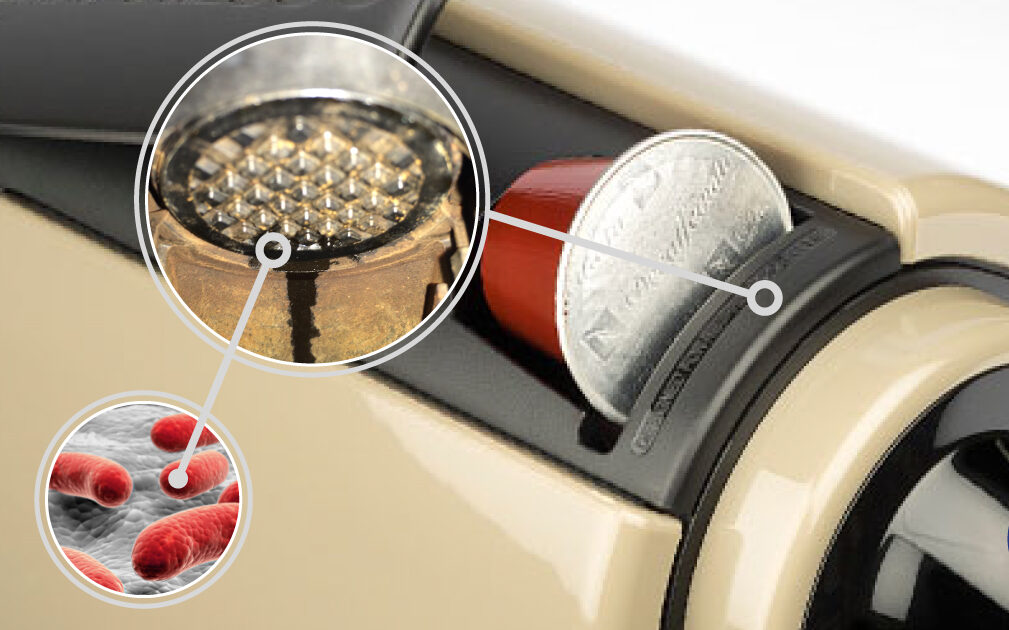
The capsule holder might not be the first thing you think of when cleaning your Nespresso machine, but it’s often the dirtiest part. Over time, grime and residue can accumulate inside it, potentially leading to issues such as capsules getting stuck or the machine leaking from the capsule box. This usually happens when the piercing plate can’t properly pierce the capsule, creating backpressure.
Here’s how you can go about it:
- Always start with the machine disconnected from the power source.
- Lift the lever to access the capsule holder.
- Use an old toothbrush and warm soapy water to clean the holder, focusing on the area where the silver part of the capsule rests.
- For hard-to-remove buildup, consider using a wire brush to clean the area effectively.
See this video to clean Gunked-Up from Pod Holder.
Defective Coffee Pod

Are you experiencing leaks while using third-party or reusable capsules in your Nespresso machine? Sometimes, the issue stems from using pods that aren’t quite the right size for your Nespresso’s capsule mechanism, leading to leaks in the capsule box.
To diagnose this issue, here’s what you can do:
Test with an Official Nespresso Pod: Grab a genuine Nespresso pod and brew a cup of coffee. If there’s no leak, it indicates that the problem is with the third-party capsules you’ve been using.
Consider Switching Brands: If using a genuine Nespresso pod solves the issue, it might be worth considering a switch to another brand of coffee pods that fits better, or sticking to the official Nespresso pods to avoid future leaks.
While it can be frustrating to find that not all pods are created equal, ensuring you use the right size can help you enjoy a leak-free coffee experience.
Advanced Issues With Nespresso Internal Components
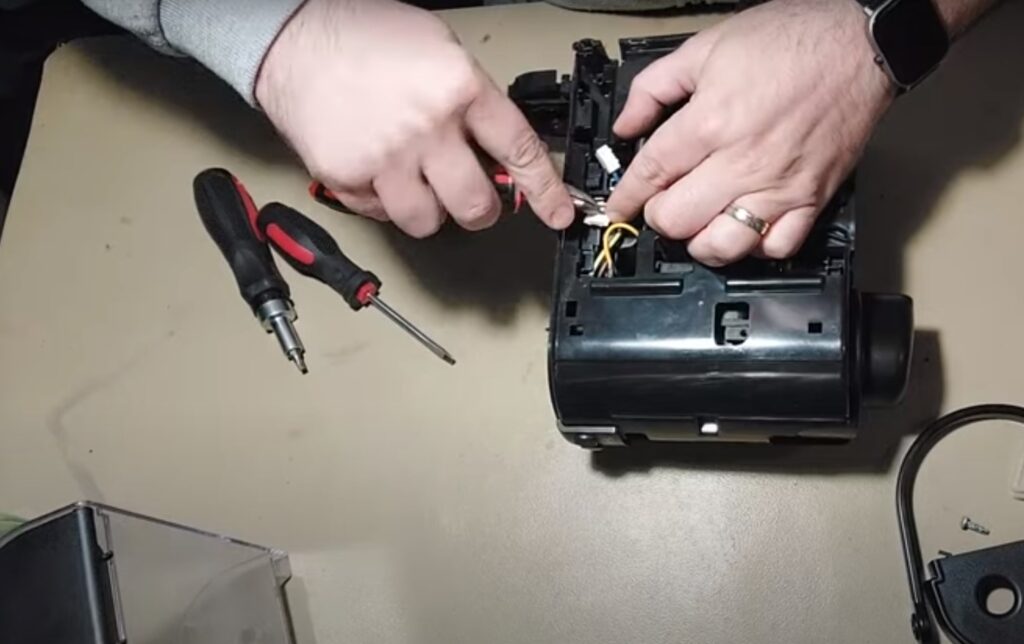
If you’ve diligently followed all the previous steps and still find your Nespresso machine leaking, it might be time to consider that there are more serious issues at play, possibly involving the machine’s internal components such as the thermoblock, pump, or internal pipework. These components are integral to your machine’s operation, and issues with them can sometimes be the root cause of persistent leaks.
Thermoblock and Boiler Issues
The thermoblock and boiler are responsible for heating the water to the perfect temperature for your coffee. However, the constant heating and cooling can cause wear and tear over time, potentially leading to leaks. If you notice a darkish pigment on the boiler, it might be a sign of continuous water dripping onto the hot component, indicating a leak.
Pump and Pipework Issues
The pump and the pipework are essential in circulating water through the machine. Sometimes, due to bumps or vibrations, components in the water circuit can come loose, causing leaks. Moreover, if you have been using vinegar for descaling, it might have damaged these sensitive components due to its acidic nature.
Diagnosing the Problem
Diagnosing issues with these components is a complex process that involves opening up the machine, a task that is not recommended for everyone as it can void the warranty and is potentially dangerous due to the involvement of electricity and water.
However, if your machine is out of warranty and you feel comfortable trying, you can attempt to identify the source of the leak by carefully removing the back screws and opening the rear panels to inspect the internal components. Always ensure the machine is unplugged before doing this to avoid electric shocks.
Once the issue is identified, whether it’s a loose component or a problem with the boiler, the solution often involves replacing the faulty part rather than attempting a repair. New genuine components tend to work better and last longer compared to repaired old parts. If it’s a minor issue like a loose component, it might be possible to reposition it and secure it firmly.
Seeking Nespresso Help
If you find yourself out of depth or if your machine is still under warranty, it is highly recommended to seek professional help. Contact Nespresso customer support at 1-800-623-033 or take your machine to a Nespresso service center for repair. They might even provide you with a replacement machine during the repair period if your warranty is still active.
Nespresso Leaking From Bottom Video Tutorial
Final Thoughts
As I wrap up my guide on fixing a Nespresso machine leaking, it’s clear that while some issues can be resolved with simple home solutions, others might require a more detailed approach or even professional assistance. From checking basic components like the water tank and drip tray to delving into more advanced internal issues, we’ve covered a range of potential problems and their solutions.
As you move forward, armed with the knowledge from this guide, I hope you find the perfect solution to any leaking issues you may be experiencing. Here’s to many more delightful and leak-free coffee moments with your Nespresso machine!
